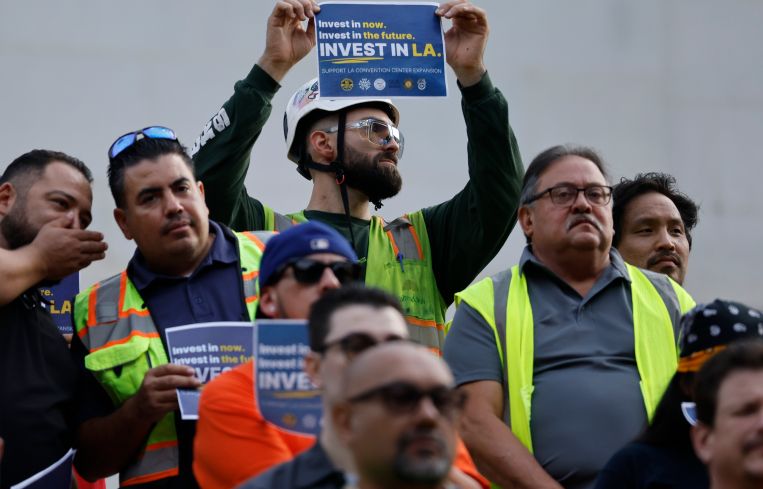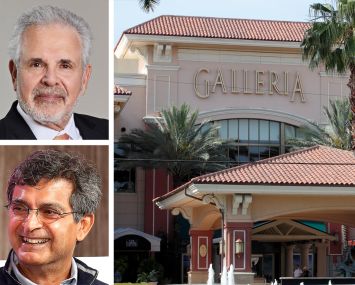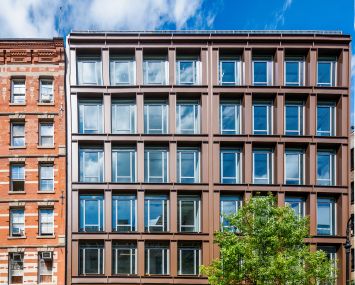Long-Awaited $3B Convention Center Expansion Gets L.A. City Council Green Light
The city must issue bonds for the project, cutting $89M a year from the general fund for the next 30 years. Only Phase 1 has a chance to be ready for the 2028 Olympics.
By Nick Trombola September 19, 2025 5:56 pm
reprints
After more than 10 years and millions of public dollars already spent on planning and revisions, the Los Angeles Convention Center is finally set to receive its multibillion-dollar expansion.
The L.A. City Council on Friday voted to move forward with the latest plans to expand the facility, which call for 190,000 square feet of new exhibit hall space, nearly 40,000 square feet of meeting space and a nearly 100,000-square-foot multi-service room. Provided there are no delays or cost overruns, the estimated cost to the city’s general fund, including capitalized interest, is just over $3 billion.
“At the end of the day, I’m voting with my constituents, because I do believe in Downtown,” Councilmember Ysabel Jurado said just before the vote. “And a strong Downtown … needs this anchor in our communities to make sure we can rise again and rise to the occasion. … It’s about lifting up the entire city. And if we want a balanced budget and a thriving city, we need to invest.”
Proponents of the expansion, which include Mayor Karen Bass, multiple City Council members and labor unions, argue that the project is a massive investment in the future of a city that is struggling with a budget deficit, insufficient tourism infrastructure and challenged economic growth. The project is expected to generate $652 million in general tax fund revenue over 30 years, plus more than $150 million in annual visitor spending, alongside 13,300 jobs during construction and additional 2,153 annual new jobs after the expansion is completed, according to a pre-vote presentation by City Administrative Officer Matt Szabo.
Some councilmembers said the plan was not an easy choice. Councilmember Eunisses Hernandez called it one of the top three most difficult decisions of her tenure because of its projected cost and timeline. The city must issue bonds in order to pay for the expansion, with an average net negative impact to the city’s general fund of $89 million over the next 30 years. That figure is reached by subtracting average debt service and operating costs, $231 million, from average annual direct and indirect revenue from the project, $142 million.
“We have taken this as far as we can,” Szabo said during the meeting. “Is the expansion possible? Yes, it is. Are there schedule risks? Yes. Will it provide substantial economic benefits? Yes. Can we afford it? Yes, but not without future tradeoffs. We will be committing funds, not just in 2030, but for 30 years after that, to support this expansion.”
The city wants to complete phase 1 of the project in March 2028 — a few months ahead of the 2028 Olympics opening ceremony on July 18 of that year. If the project phase is delayed past that deadline, Olympic and Paralympic events scheduled to take place at the current convention center must find a new venue.
The full project is expected to be completed in 2029.
“The City Council is threatening to saddle L.A. taxpayers with decades of debt payments to pay for a Convention Center expansion that they’re rushing to approve in time for the Olympics,” the Howard Jarvis Taxpayers Association said in a statement. “It’s completely unfair to the taxpayers to put this unaffordable vanity project ahead of all the important priorities placing demands on the city’s budget.”
Council Budget Chair Katy Yaroslavsky also voiced concerns. Along with pointing out that the city has already faced drastic budget deficits, Yaroslavsky called the risks associated with the project enormous, and said it could threaten services used by residents across L.A., and will consume all projected general fund growth for the foreseeable future.
That means the city will have no funds for initiatives like expediting the hiring of additional police officers or expanding its fire department; repairing sidewalks that cost $100 million in annual liabilities; or building bike lanes and making communities walkable, Yaroslavsky said.
“A ‘yes’ vote will tie our hands financially for decades, while our existing obligations are about to explode,” Yaroslavsky said Friday. “I’ve heard the arguments about the opportunity costs of inaction, and those are valid. We should’ve done this 10 years ago.
“One of the arguments that seems to be carrying the day is that our predecessors failed to act for years, and if we don’t act now, the price is just going to keep going up. And that’s true. But when you can’t afford something, you don’t buy it because it will be more expensive later. You buy what you can afford.”
L.A. City Controller Kenneth Meija also spoke out against the expansion project the night before the vote, posting to his office’s Instagram account that he cannot back the project if the city continues to fail to address its systemic budget challenges.
“Due to the city’s consistent budgetary and financial problems with no real solutions for long-term fiscal health and uncertainties regarding the ambitious timeline of completion, our office cannot recommend going forward with the current plan at this time,” Meija wrote.
Still, Bass in particular has remained a champion of the project, highlighting the thousands of jobs, eventual revenue and tourism boost that the city will see from an expanded convention center.
“This is about more than a building, it is about catalyzing change in Downtown and the entire city and bringing more travelers to our restaurants, hotels, stores and attractions,” Bass said in a statement. “Tourism is a massive economic driver. The convention business is highly competitive, but with this effort, we are sending a signal that Los Angeles is ready to compete and win on a global scale. Our decision is a signal about the kind of L.A. we are building for future generations. We must move our city forward.”
Nick Trombola can be reached at ntrombola@commercialobserver.com.


